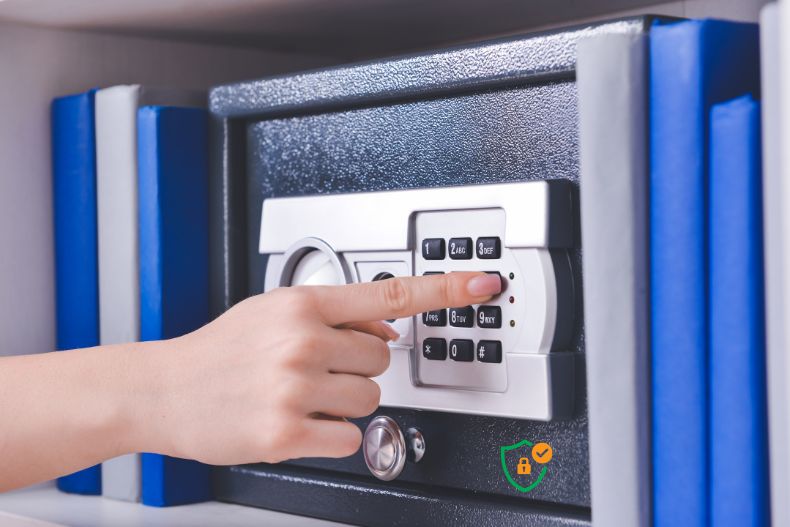A safe deposit box is a secure storage option for safeguarding important documents and valuables. Typically offered by banks and other financial institutions, these metal boxes come in various sizes and are stored inside the bank’s vault. However, limited access and strict regulations can make them less convenient for some.
Alternatively, non-bank safety deposit options can be used at home. These include customized boxes for specific goods, jewelry safety deposit boxes, wall-mounted options, digital safes, fireproof boxes, and more.
Let’s explore the top reasons why a non-bank safe deposit box might be a better choice for protecting your goods or valuables.

Privacy and Anonymity
Non-bank safe deposit boxes often provide greater privacy and anonymity compared to traditional bank safe deposit boxes. Non-bank facilities frequently require minimal personal information, appealing to individuals concerned about privacy and potential government overreach. Protecting one’s personal data remains a priority in choosing a storage solution. A non-bank facility commonly ensures that the client’s private information remains confidential, thus providing a layer of security from external scrutiny. The desire for privacy is a significant factor driving individuals toward non-bank options.
Accessibility and Flexibility
Non-bank safe deposit boxes offer enhanced accessibility compared to those provided by banks. Traditional bank safety deposit boxes are typically accessible only during banking hours, which can be restrictive. Non-bank facilities often provide more flexible access hours, sometimes even allowing clients to access their valuables outside of regular business hours. This flexibility is beneficial for individuals who may require frequent or urgent access to their stored items. For instance, travelers often need access to their valuables at irregular times, making non-bank solutions more convenient. Some private institutions in locations such as Hong Kong offer such flexibility, as exemplified by facilities like a private safe deposit box in Hong Kong.
Security Features
Non-bank safe deposit boxes may offer advanced security features. While both bank and non-bank facilities prioritize security, non-bank providers may implement biometric access, advanced surveillance systems, and disaster-resistant infrastructure. These features aim to enhance the protection of valuables against unauthorized access and natural disasters. However, it is important to acknowledge that no facility is completely immune to theft or damage. It is advisable for individuals to verify the security measures in place at any non-bank facility under consideration. Evaluating access protocols and surveillance systems is crucial for making an informed decision.
Risks and Considerations
Non-bank facilities present certain risks and considerations that should be carefully evaluated. One significant risk is the lack of insurance. Contents of non-bank safe deposit boxes are not insured by the Federal Deposit Insurance Corporation or other government agencies. Consequently, valuables stored in these boxes are not protected in cases of theft, loss, or damage. Customers may need to consider private insurance options to safeguard their assets.
Legal and regulatory risks are another consideration. Non-bank facilities may be subject to different legal and regulatory standards compared to banks. The FBI raid on a non-bank vault in Beverly Hills serves as a pertinent example, raising concerns about privacy and constitutional rights. Such events highlight the necessity of understanding the legal protections and vulnerabilities associated with using non-bank safe deposit boxes.
Cost Comparison
The cost of renting non-bank safe deposit boxes can vary significantly. While some non-bank facilities might charge higher fees than traditional banks, the value proposition should be evaluated based on the services and security offered. Comparing prices and services among various providers is essential to ensure value for money. Traditional banks typically charge between $15 to $350 annually for safe deposit boxes, depending on factors like box size, bank, and location. Non-bank facilities may have a different pricing structure, and potential clients should perform a detailed comparison before committing.
Market Trends and Consumer Preferences
The demand for non-bank safe deposit boxes is influenced by market trends and consumer preferences. Traditional banks are increasingly phasing out safe deposit boxes due to high maintenance costs and low profitability. This shift has led to a heightened interest in non-bank alternatives. Moreover, consumer dissatisfaction with bank services has driven individuals to seek alternatives. Issues such as mishandling of boxes or limited access during emergencies reinforce the appeal of non-bank options.
Court rulings that emphasize privacy rights also influence consumer decisions. Legal precedents, such as the case involving the FBI raid in Beverly Hills, underscore the importance of privacy and may sway individuals toward non-bank facilities that prioritize confidentiality.
Additional Considerations for Safe Deposit Boxes
A safe deposit box is typically a long metal box stored in a bank or credit union vault, with box sizes ranging from 3 by 5 inches to 10 by 10 inches. Items typically stored include vital records, legal documents, and valuables. Banks use dual-key systems for security, involving a physical or electronic key to open the vault and a separate key for the customer’s box. Rental fees vary based on box size and location.
Safe deposit boxes are designed to withstand natural disasters such as fires and floods, providing an extra layer of security for physical documents or items. However, there are specific items not recommended for storage in safe deposit boxes, such as cash or items that may be needed urgently, like living wills or medical directives. These should be readily accessible and housed in alternative secure locations, such as a home safe.
Banks occasionally offer discounted or even free safe deposit boxes for customers with certain account types, but the demand for these services has decreased, particularly among younger customers who prefer digital or home storage options. The reduction in leased safe deposit boxes can also be attributed to the rising preference for digital storage solutions.
Conclusion
Utilizing a non-bank safe deposit box offers various advantages, including enhanced privacy, flexible access hours, and advanced security features. It also presents unique risks and considerations, such as the lack of FDIC insurance and potential legal vulnerabilities. Market trends and consumer preferences are shifting towards non-bank solutions due to perceived advantages over traditional banks. Ultimately, the decision should be based on a thorough evaluation of security measures, accessibility, and cost to ensure that the choice aligns with individual needs and priorities.











